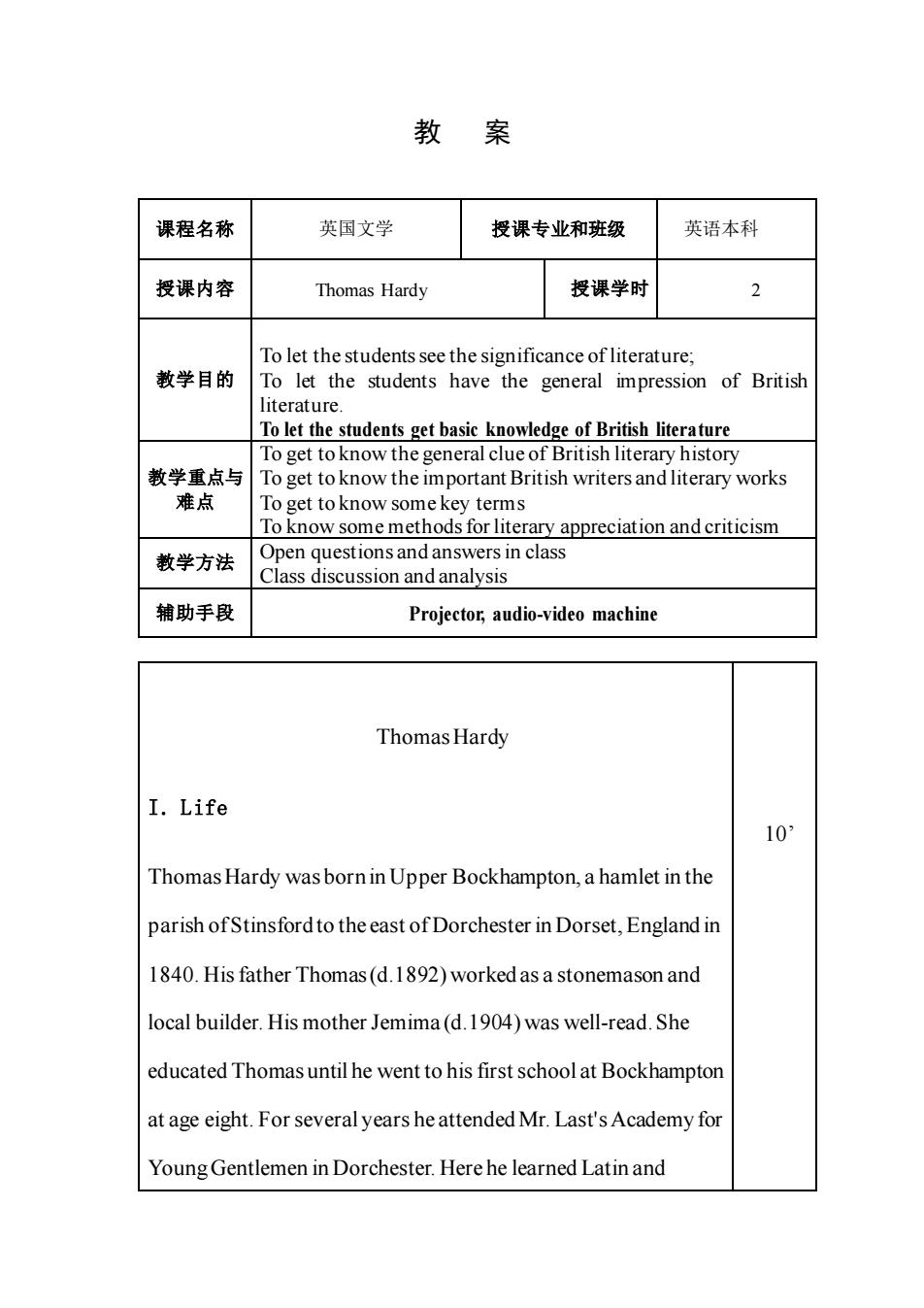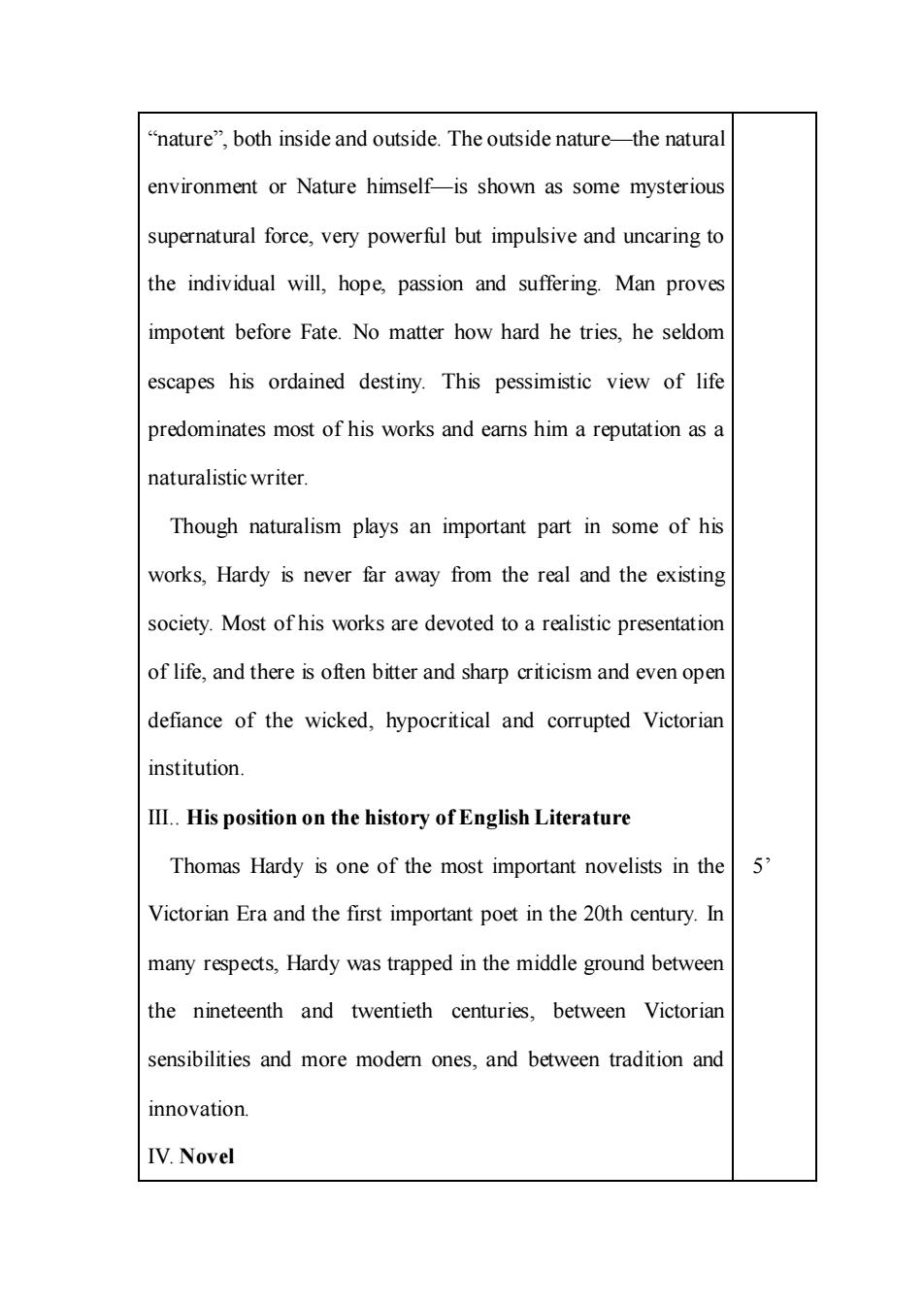
教案 课程名称 英国文学 授课专业和班级 英语本科 授课内容 Thomas Hardy 授课学时 To let the students see the significance of literature; 教学目的 To let the students have the general impression of British terature To let the students get basic knowledge of British literature To get to know the general clue of British literary history 教学重点与To get to know the important British writers and literary works 难点 To get toknow some key terms Toknowsome methods for literary 教学方法 Open questions and answers in class Class discussion and analysis 辅助手段 Projector,audio-video machine Thomas Hardy I.Life 10 Thomas Hardy was born in Upper Bockhampton,a hamlet in the parish ofStinsfordto the east of Dorchester in Dorset,England in 1840.His father Thomas(d.1892)worked as a stonemason and local builder.His mother Jemima(d.1904)was well-read.She educated Thomas until he went to his first school at Bockhampton at age eight.For several years he attended Mr.Last's Academy for Young Gentlemen in Dorchester.Here he learned Latin and
教 案 课程名称 英国文学 授课专业和班级 英语本科 授课内容 Thomas Hardy 授课学时 2 教学目的 To let the students see the significance of literature; To let the students have the general impression of British literature. To let the students get basic knowledge of British literature 教学重点与 难点 To get to know the general clue of British literary history To get to know the important British writers and literary works To get to know some key terms To know some methods for literary appreciation and criticism 教学方法 Open questions and answers in class Class discussion and analysis 辅助手段 Projector, audio-video machine Thomas Hardy I. Life Thomas Hardy was born in Upper Bockhampton, a hamlet in the parish of Stinsford to the east of Dorchesterin Dorset, England in 1840. His father Thomas (d.1892) worked as a stonemason and local builder. His mother Jemima (d.1904) was well-read. She educated Thomas until he went to his first school at Bockhampton at age eight. For several years he attended Mr. Last's Academy for Young Gentlemen in Dorchester. Here he learned Latin and 10’

demonstrated academic potential.[1]However,a family of Hardy's social position lacked the means for a university education,and his formal educationended at the age of sixteen when he became apprenticed to James Hicks,a localarchitect.[2] Hardy trained as an architect in Dorchester before moving to London in 1862;there heenrolled as a student at King's College, London.He won prizes from the Royal Institute ofBritish Architects and the Architectural Association.Hardy never felt at home in London.He was acutely conscious ofclass divisions and his social inferiority.However,he was interested in socialreform and was familiar with the works of John Stuart Mill.He was also introduced to the worksofCharles Fourier and Auguste Comte duringthis period by his Dorset friend,Horace Moule.Fiveyears later,concerned about his health,hereturned to Dorset and decided to dedicate himselfto writing. In 1870,while on an architectural mission to restore the parish church of St Juliot in Cornwall,[3]Hardy met and fell in love 10 with Emma Lavinia Gifford,whom he married in 1874.[4][5] Although he later becameestranged from his son her death in 1912 had a traumatic effect on him.After her death,Hardy made a trip to Cornwall to revisit places linked with their courtship,and
demonstrated academic potential.[1]However, a family of Hardy's social position lacked the means for a university education, and his formal education ended at the age of sixteen when he became apprenticed to James Hicks, a local architect.[2] Hardy trained as an architect in Dorchester before moving to London in 1862; there he enrolled as a student at King's College, London. He won prizes from the Royal Institute of British Architects and the Architectural Association. Hardy never felt at home in London. He was acutely conscious of class divisions and his social inferiority. However, he was interested in social reform and was familiar with the works of John Stuart Mill. He was also introduced to the works of Charles Fourier and Auguste Comte during this period by his Dorset friend, Horace Moule. Five years later, concerned about his health, he returned to Dorset and decided to dedicate himself to writing. In 1870, while on an architectural mission to restore the parish church of St Juliot in Cornwall,[3]Hardy met and fell in love with Emma Lavinia Gifford, whom he married in 1874.[4][5] Although he later became estranged from his son her death in 1912 had a traumatic effect on him. After her death, Hardy made a trip to Cornwall to revisit places linked with their courtship, and 10’

his Poems 1912-13reflect upon her death.In 1914,Hardy married his secretary Florence Emily Dugdale,who was 39 years his junior.However,he remained preoccupied with his first wife's death and tried to overcome his remorse by writingpoetry.[6] Hardy became ill with pleurisy in December 1927and died at Max Gate just after 9 pm on 11 January 1928,having dictated his final poem to his wife on his deathbed;the cause ofdeath was cited,on his death certificate,as"cardiacsyncope",with"old age"given as a contributory factor.His funeral was on 16 January at Westminster Abbey,and it proved a controversial occasion because Hardy and his family and friends had wished for his body to be interred at Stinsford in the same graveas his first wife Emma.However,his executor,Sir Sydney Carlyle Cockerell, insisted that he be placed in theabbey's famous Poets'Corner.A compromise was reached whereby his heart was buried at Stinsford with Emma,and his ashes in Poets'Corner. Shortly after Hardy'sdeath,theexecutorsofhis estate burnt his letters and notebooks.Twelve records survived,one ofthem 10 containing notes and extracts ofnewspaper stories from the 1820s.Research into these provided insight into how Hardy kept track ofthem and how he used them in his later work.[7]In the
his Poems 1912–13 reflect upon her death. In 1914, Hardy married his secretary Florence Emily Dugdale, who was 39 years his junior. However, he remained preoccupied with his first wife's death and tried to overcome his remorse by writing poetry.[6] Hardy became ill with pleurisy in December 1927 and died at Max Gate just after 9 pm on 11 January 1928, having dictated his final poem to his wife on his deathbed; the cause of death was cited, on his death certificate, as "cardiac syncope", with "old age" given as a contributory factor. His funeral was on 16 January at Westminster Abbey, and it proved a controversial occasion because Hardy and his family and friends had wished for his body to be interred at Stinsford in the same grave as his first wife, Emma. However, his executor, Sir Sydney Carlyle Cockerell, insisted that he be placed in the abbey's famous Poets' Corner. A compromise was reached whereby his heart was buried at Stinsford with Emma, and his ashes in Poets' Corner. Shortly after Hardy's death, the executors of his estate burnt his letters and notebooks. Twelve records survived, one of them containing notes and extracts of newspaper stories from the 1820s. Research into these provided insight into how Hardy kept track of them and how he used them in his later work.[7]In the 10’

year ofhis death Mrs Hardy published The Early Life of Thomas Hardy,1841-1891:compiled largely from contemporary notes, letters,diaries,and biographical memoranda,as well as from oral information in conversations extendingover many years Hardy's work was admired by many writers ofa younger generation including D.H.Lawrence and Virginia Woolf.In his autobiography Goodbye to All That,Robert Graves recalls meeting Hardy in Dorset in the early 1920s.Hardy received him and his new wife warmly,and was encouraging about his work. In 1910,Hardy wasawarded the Order ofMerit. Hardy's cottage at Bockhampton and Max Gate in Dorchester are owned by the National Trust. II.Points of View: 10 Hardy is much influenced by scientific discoveries and philosophers of the new school.He read Darwin's Origin of Species and accepted his theory of "survival of the fittest."His reading of Spencer's First Principle inspired his pessimistic determinism and led him to the belief that man's fate was predeterminedly tragic. In his works,man is shown driven by a combined force of
year of his death Mrs Hardy published The Early Life of Thomas Hardy, 1841–1891: compiled largely from contemporary notes, letters, diaries, and biographical memoranda, as well as from oral information in conversations extending over many years. Hardy's work was admired by many writers of a younger generation including D. H. Lawrence and Virginia Woolf. In his autobiography Goodbye to All That, Robert Graves recalls meeting Hardy in Dorset in the early 1920s. Hardy received him and his new wife warmly, and was encouraging about his work. In 1910, Hardy was awarded the Order of Merit. Hardy's cottage at Bockhampton and Max Gate in Dorchester are owned by the National Trust. II. Points of View: Hardy is much influenced by scientific discoveries and philosophers of the new school. He read Darwin’s Origin of Species and accepted his theory of “survival of the fittest.” His reading of Spencer’s First Principle inspired his pessimistic determinism and led him to the belief that man’s fate was predeterminedly tragic. In his works, man is shown driven by a combined force of 10’

"nature",both inside and outside.The outside nature-the natural environment or Nature himselfis shown as some mysterious supernatural force,very powerful but impulsive and uncaring to the individual will,hope,passion and suffering.Man proves impotent before Fate.No matter how hard he tries,he seldom escapes his ordained destiny.This pessimistic view of life predominates most of his works and earns him a reputation as a naturalistic writer. Though naturalism plays an important part in some of his works,Hardy is never far away from the real and the existing society.Most of his works are devoted to a realistic presentation of life,and there is often bitter and sharp criticism and even open defiance of the wicked,hypocritical and corrupted Victorian institution. III.His position on the history of English Literature Thomas Hardy is one of the most important novelists in the 5 Victorian Era and the first important poet in the 20th century.In many respects,Hardy was trapped in the middle ground between the nineteenth and twentieth centuries,between Victorian sensibilities and more modern ones,and between tradition and innovation. IV.Novel
“nature”, both inside and outside. The outside nature—the natural environment or Nature himself—is shown as some mysterious supernatural force, very powerful but impulsive and uncaring to the individual will, hope, passion and suffering. Man proves impotent before Fate. No matter how hard he tries, he seldom escapes his ordained destiny. This pessimistic view of life predominates most of his works and earns him a reputation as a naturalistic writer. Though naturalism plays an important part in some of his works, Hardy is never far away from the real and the existing society. Most of his works are devoted to a realistic presentation of life, and there is often bitter and sharp criticism and even open defiance of the wicked, hypocritical and corrupted Victorian institution. III. His position on the history of English Literature Thomas Hardy is one of the most important novelists in the Victorian Era and the first important poet in the 20th century. In many respects, Hardy was trapped in the middle ground between the nineteenth and twentieth centuries, between Victorian sensibilities and more modern ones, and between tradition and innovation. IV. Novel 5’